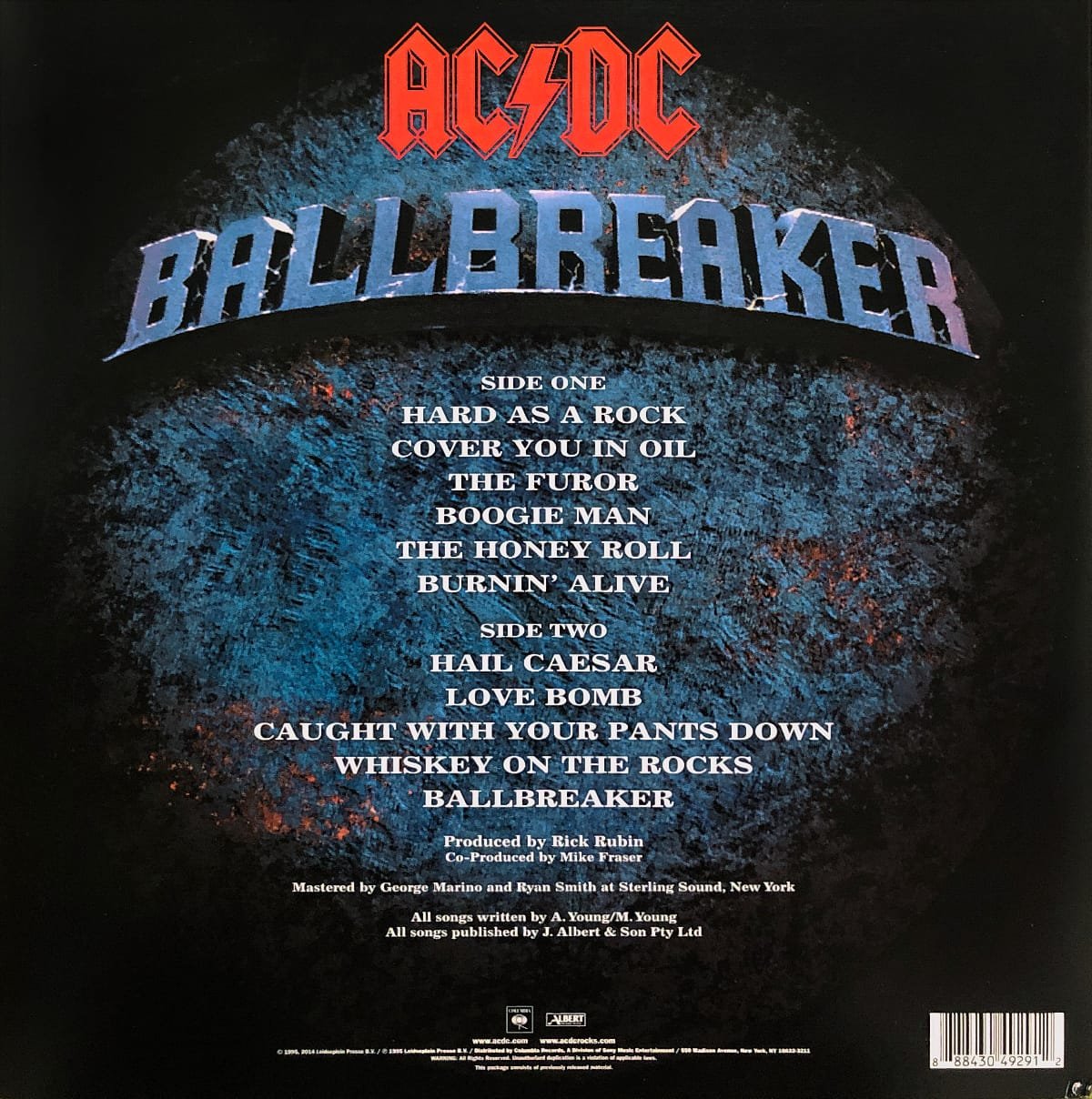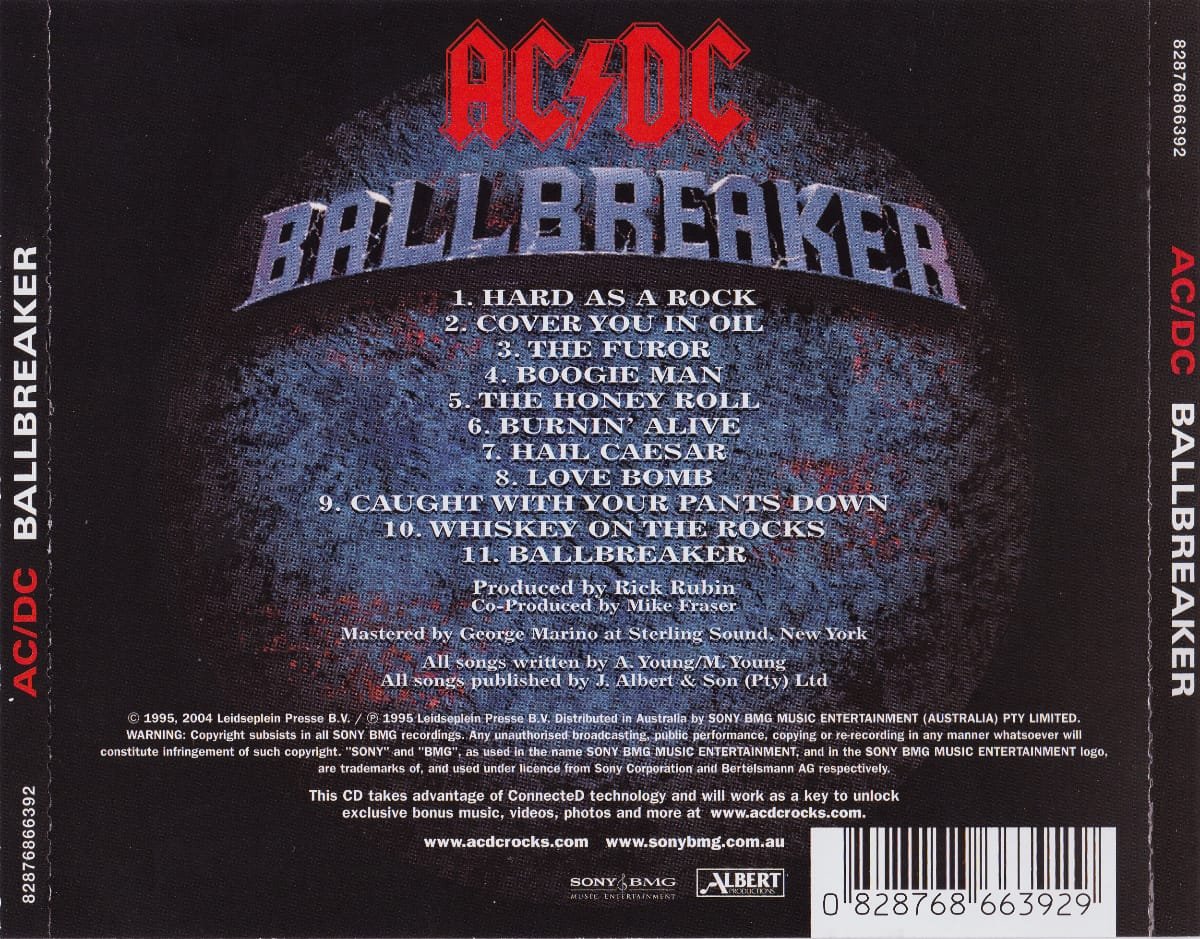AC/DC first appeared on my radar when the band released The Razors Edge in 1990. At the time, a friend of mine was a walking encyclopedia on everything AC/DC and he quickly convinced me that they were the band! It is a proud parenting moment to acknowledge that this admiration and influence has now been bestowed on my son and he tells all who will listen about the greatest rock and roll band in the world: Acca Dacca.
While it would be close to a decade before I owned a copy of The Razors Edge, I did pick up the second single, Hail Caesar, from their 1995 release Ballbreaker. The Hail Caesar CD single also featured Ballbreaker’s B-side Whiskey On The Rocks and a live performance of Whole Lotta Rosie from their European tour in 1991. Both songs were excellent additions to the single. The version of Whole Lotta Rosie was labelled as a previously unreleased recording, hence not part of the 1992 Live album. Thus, collectors would be advised to grab a copy of the single to secure this recording.
However, it is fair to say that the AC/DC fan base didn’t lose their collective minds when Ballbreaker was released. While nothing could topple the success of Back In Black and The Razors Edge, Ballbreaker had modest sales success and is often viewed in the same category as Flick Of The Switch and Fly On The Wall; valued and essential interim albums, but not their most adored. Subjectively, I have found that I am often drawn to the less successful albums in their catalogue.
Alongside the Hail Caesar CD single, I picked up this masterpiece on cassette. At the time, my Sony Cassette Walkman (WM-FX507) was a constant companion and while I could have created a mixtape, I preferred to collect the retail releases of cassette albums as the liner notes were often redesigned and unique when compared to the LP or CD counterpart. Thankfully, the Ballbreaker cassette was not a disappointment as the comic-based graphic design, was reimagined throughout the foldout liner notes and was simply gorgeous. This is one aspect that I truly miss in the modern era and while the vinyl revival has brought album artwork back to the forefront of the music listening experience, the unique presentation of the compact cassette, when done properly, is sorely missed. Now, if we can only get liner notes on all streaming services and digital stores I would be happy.
While I am aware that the Apple Digital Master edition of Ballbreaker contains an iTunes LP, the iTunes LP feature is still restricted to playback on a Mac or PC and is no longer being supported, for new releases, by Apple. A shame considering the concept bridges the gap between the tactile physical release and the digital equivalent thereby allowing everyone to have a similar experience. I honestly have never understood how Apple could not have implemented iTunes LP in devices such as the iPhone, iPad, or Apple TV thereby creating a seamless experience as they do with films. In my opinion, it is a missed opportunity and would have set iTunes and Apple Music apart from the competition. Regardless, at least you can still purchase the AC/DC releases in iTunes LP but be wary as one must question just how long these releases will continue to be supported on the Mac and PC.
Speaking of LP-sized artwork, the 2014 vinyl re-issue of Ballbreaker is spectacular to hold, although the lyrics that were present with the original Vinyl, CD, and Cassette release are missing from both the LP liner notes and the 2004 CD reissue. One could argue that the write-up and reflection are better suited in retrospect, but I know many who would lament the absence of lyrics. I do, however, enjoy the newer liner notes and the series of live photographs and graphic illustrations from the original release but it would have been great if the liner notes in these reissues had been further expanded to include the lyrics.
What has remained the same, however, is the Ballbreaker cover; one of AC/DC’s best and most striking. That said, Stiff Upper Lip is my all-time favourite. While the rear cover is bland, it serves a purpose and does not include anything that doesn’t need to be there. Plus, my ageing eyesight is grateful for the larger typeface as so many releases choose the smallest possible fonts for seemingly no good reason, other than design aspects, when it comes to the track listing and liner notes in general.
While I have never owned the original vinyl releases of AC/DC’s catalogue, the remastered reissues, mastered at Sterling Sound by George Marino and Ryan Smith are a true gift to AC/DC fans. The pressing is silent and is one of the better rock and roll re-issues with deep bass lines, clear vocals, and a guitar track so pure that you would swear the band was in the room with you. Yes, dear reader, that experience also translates to the CD and Apple Music counterparts. Other than the analogue warmth, you’re getting exactly the same sonic presentation across all formats. Yes, the vinyl edition increases the dynamic range but let’s be honest, this is AC/DC and as long as you can rock out and turn the volume to 11 then the dynamic range is of little importance. In my experience, the digital editions that are technically in the red sound as good, if not better, than the more dynamic vinyl reproduction. That may seem to be a counterintuitive argument as brickwalling can kill a good record, but this isn’t brickwalling in the traditional sense as you’re not missing out on any sonic elements. The hi-hats shimmer, the bass is where it needs to be, and Brian Johnson’s vocal is clearer and cleaner than ever.
Long time readers would note my love of vinyl, but if you get a chance, don’t ignore the CD counterpart for it is really something special. For those of you that prefer to stream their music, the good news is you’ll thoroughly enjoy a near-transparent to the CD reproduction via the Apple Music stream as this is an Apple Digital Master done right.
Hard As A Rock is, without a doubt, one of the best tracks to start any rock and roll album on. It sets the tone immediately with AC/DC’s renowned sound signature and innuendo-filled lyrics. The rhythmic blues-infused rock and roll sound is addictive and while many naysayers will complain that AC/DC plagiarises their own work, at least you know what you’re going to get.
Cover You In Oil has an incredible slower tempo that I adore and feel it is a precursor to the styling on Stiff Upper Lip; one of AC/DC’s best albums in my opinion.
The Furor has a killer guitar intro that builds into an epic song. However, I feel Brian’s lyrical delivery is strained and his magic is subsequently missing on this song. It could also be the mix, but it just doesn’t sound right to me.
Boogie Man is groovy!
The Honey Roll offers the perfect mix of rock and roll and blues. Every element, from the rhythm section to the lead guitar and vocals is textbook perfect. It doesn’t get much better than this.
Burnin’ Alive simply doesn’t resonate with me in its current position on the album. While I won’t stop the record prematurely, or skip the song, it is distracting. It isn’t fundamentally bad, just poorly tracked.
Hail Caesar is, arguably, the reason I’m an AC/DC fan. The song subsequently holds a very special place in my heart. It’s also one of their hardest hitting songs on the album and one that could make a stadium audience sing in unison. Angus’ guitar solo is off the charts and Brian’s vocals are also perfect insofar as I can understand the words he’s singing, outside of the chorus. While he doesn’t slur his words, I have found that his vocal clarity can get lost in the music as a result of his natural growl.
Love Bomb reminds me of the 80s hair metal scene. The song is great, but the association is a little disconcerting.
Caught With Your Pants Down is classic AC/DC.
Whiskey On The Rocks is a favourite of mine, most likely due to the excessive number of times it was played on the Hail Caesar single. Isn’t it amazing how songs can grow on you if you listen to them enough? That said, listening to a song too often can make you hate a perfectly good song as well. In retrospect, perhaps that is why I have formed a love/hate relationship with Whole Lotta Rosie, yet in a cruel dichotomy, I never tire of Thunderstruck.
Ballbreaker closes out the album with a song that has ‘stadium anthem’ written all over it. As all closing tracks should, it encourages me to listen to the album again and stay within AC/DC’s extensive catalogue.
While Rick Rubin is likely responsible for the raw sound found throughout Ballbreaker, it’s fantastic to have an AC/DC album that truly highlights the building blocks of rock and roll music; the blues. While AC/DC explored this sound further, without Rubin, on the Stiff Upper Lip album, it is a style that I subjectively appreciate and one that highlights the musical influences and origins of one of the greatest rock and roll bands the world has ever seen.
My only disappointment with Ballbreaker is that Big Gun (also Rubin produced) wasn’t included on the album as it was only recorded and released the year before. It is one of my all-time favourite AC/DC songs, and while I acknowledge that it was written and recorded for the Last Action Hero soundtrack, it would have made a perfect addition to Ballbreaker. Big Gun is another stadium-filling song that deserves to be turned up to 11.
While Ballbreaker may not be the first album fans go to when they think of AC/DC, it is an exceptional addition to their catalogue and one that should never be overlooked. As controversial as this may be, I’d take Ballbreaker over Back In Black any day of the week.









